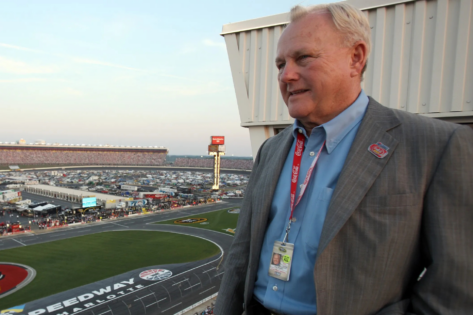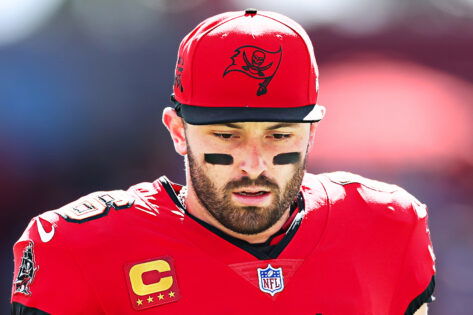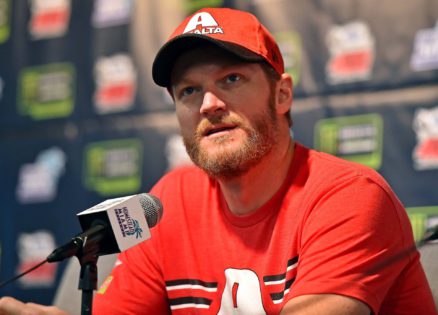Why did fans refer to Humpy Wheeler as the P.T. Barnum of NASCAR? In 1985, when the Coca-Cola 600 was crowded at Charlotte Motor Speedway, Wheeler decided to bet on spectacle once more. A stuntman known as “The Flying Greek” flew into the air in a school bus and jumped over a line of junk cars in the infield while the crowd waited for the green flag. The stadium roared, not for a lap finished, but for a spectacular performance that only Wheeler could have imagined.
Wheeler transformed Charlotte into NASCAR’s ultimate stage for almost thirty years, fusing theater and racing in ways that the sport had never seen before. Now that he is one of the candidates for the 2026 class of the NASCAR Hall of Fame, attention is once again focused on the guy whose showmanship not only improved a racetrack but also contributed to the definition of an era.
Who is Humpy Wheeler?
A prominent figure in American racing, H.A. “Humpy” Wheeler is most remembered for his revolutionary leadership during his tenure as president and general manager of Charlotte Motor Speedway from 1975 to 2008. Wheeler, who was born in Belmont, North Carolina, on October 23, 1938, gained the moniker “P.T. Barnum of NASCAR” for his creative race promotion strategies. During his tenure, NASCAR’s national profile was raised, and the fan experience was transformed by innovative ideas.
Despite early opposition from NASCAR officials, Wheeler’s talent for entertainment produced unforgettable pre-race spectacles, such as a three-ring circus with trapeze artists and elephants and a stunt in which “Jimmy, The Flying Greek” leaped a school bus over a line of junked cars. He also had a key role in the development of night racing at superspeedways and the “NASCAR Experience,” which brought spectators closer to the action. These initiatives raised the bar for motorsports fan interaction and made Charlotte Motor Speedway a world-class racing attraction.
Wheeler has received widespread recognition for his services to the sport. In addition to being a nominee for the NASCAR Hall of Fame Class of 2026 in the Landmark Award category, which recognizes noteworthy contributions to the development and prestige of NASCAR, he was inducted into the International Motorsports Hall of Fame in 2006. In addition to his skill as a promoter, Wheeler left behind a legacy of coaching upcoming business titans and supporting fan-focused innovations that still have an impact on the sport today. His place as one of the most significant individuals in the history of auto racing has been cemented by his theatrics and innovative leadership, which have permanently altered NASCAR.
Humpy Wheeler’s role in transforming Charlotte Motor Speedway
As one of the first track promoters to treat fans like paying guests at a major show, Humpy Wheeler played a pivotal role in turning Charlotte Motor Speedway from a traditional racetrack into one of the most iconic and fan-friendly venues in motorsports. Under his direction, Charlotte became the gold standard for race-day entertainment, introducing large-scale pre-race shows with skydivers, pyrotechnics, and themed promotions—often tying them to cultural events or current trends to attract a wider audience. In 2001, Wheeler made history by organizing a pre-race celebration that involved 5,000 firefighters and was inducted into the Guinness Book of World Records.
When he set up “The Flying Greek” to leap a school bus over a line of automobiles in the infield before the Coca-Cola 600 in 1985, it became one of his most well-known promotions. Not only was that kind of flair entertaining, it was also calculated. Charlotte was able to maintain its advantage in both TV ratings and attendance thanks to it. Wheeler also pushed for the introduction of lights at Charlotte in 1992, helping to pioneer night racing at superspeedways. As a result, the NASCAR All-Star Race under the lights was born, and it is now a fan favorite and a mainstay of the Cup Series schedule. Additionally, he sought to increase exposure, safety, and accessibility, making Charlotte one of NASCAR’s most media-friendly racetracks.
Announcing the 2026 Landmark Award nominees, with Former President and General Manager of Charlotte Motor Speedway, Humpy Wheeler, joining the ballot alongside Alvin Hawkins, Lesa France Kennedy, Dr. Joseph Mattioli and Les Richter. #NASCARHall pic.twitter.com/poU0ZVzpS3
— NASCAR Hall of Fame (@NASCARHall) April 21, 2025
Wheeler was one of the first to recognize the value of fan devotion and branding. Long before driver branding became commonplace, he actively promoted drivers as personalities and developed original events like the “10 Greatest Moments in NASCAR” exhibit. In addition to redefining Charlotte Motor Speedway, Wheeler had changed NASCAR’s perspective on entertainment and promotion by the time he resigned in 2008. Many of the immersive fan experiences that exist today have their origins in the model he established. Wheeler’s position as the trailblazer who elevated racing above the race itself is solidified as he is now being acknowledged on the biggest stage in the sport as a 2026 NASCAR Hall of Fame contender in the Landmark Award category.
From promoting motorsports events to advocating motorsports safety, Humpy Wheeler’s multifaceted roles
Apart from being a promoter, Humpy Wheeler was a visionary who had many roles that each had a unique impact on NASCAR. His impact at Charlotte Motor Speedway and elsewhere goes far beyond the hoopla and fireworks. Wheeler’s diverse impact left a lasting impression on all facets of motorsport, from subtly changing the sport’s commitment to safety to pushing the limits of race-day theatrics. Because of Wheeler’s brilliant marketing, races are now must-attend events. Embracing theatrics, he planned extravagant pre-race festivities that included everything from school bus jumps and circus-style parades to jet flyovers and simulated military invasions. However, his goal was to develop an emotional hook that attracted new followers to the sport, not only to generate excitement.
Giving fans more than they paid for was his straightforward yet revolutionary idea. This way of thinking contributed to NASCAR’s rise in popularity during the 1980s and 1990s, particularly during a period of peak public interest. Under his direction, Charlotte became the premier illustration of how a racetrack might serve as an entertainment venue. Wheeler’s commitment to motorsport safety was less ostentatious but no less significant. Wheeler adopted a hands-on approach to enhancing driver and fan safety because he had a degree in finance and a thorough technical understanding of race operations.
He campaigned for improved cooperation between tracks, NASCAR, and safety developers and promoted ideas like SAFER barriers. In addition, Wheeler advocated for better pit road practices and was a strong supporter of the track’s emergency response standards, which were influenced in part by his personal experience with severe wrecks. For Wheeler, motorsport was a long-term endeavor. He frequently spoke at universities or coached up-and-coming talent at Speedway Motorsports in an effort to mentor young promoters, engineers, and marketing specialists. His guidance produced a generation of business leaders who continued his audacious ideas and fan-first philosophy.
Wheeler, who is arguably unappreciated, was also instrumental in diversifying NASCAR’s image. At a time when the sport was being criticized for its lack of inclusion, he pushed for outreach into new markets and backed driver development initiatives. His capacity to comprehend local identities and relate NASCAR’s Southern heritage to a wider national audience paved the way for the sport’s expansion.
Humpy Wheeler’s talents extended far beyond the grandstands, whether he was planning a pre-race stunt that garnered media attention or subtly advocating for advancements that could save lives. He never forgot who the sport was truly for: the fans. He helped to advance the sport, safeguard its members, and get it ready for the future.
Humpy Wheeler’s road to becoming NASCAR Hall of Fame nominee
H.A. “Humpy” Wheeler’s path to being nominated for the 2026 NASCAR Hall of Fame is evidence of his revolutionary influence on the sport. As Charlotte Motor Speedway’s longtime president and general manager, Wheeler transformed the fan experience and raised NASCAR’s image across the country. Wheeler’s 33-year career at Charlotte Motor Speedway was distinguished by his inventiveness and charisma. He transformed races into full-fledged entertainment events by introducing theatrical pre-race festivities, complete with intricate stunts and themed promotions. Through his efforts, Charlotte’s standing as the “Racing Capital of the World” was cemented, drawing in a wide range of supporters and corporate sponsors.
Beyond the show, Wheeler played a key role in putting fan-focused programs into action. To bring fans closer to the action, he devised the “NASCAR Experience” and oversaw the construction of the famous Turn 4 grandstands. Additionally, night racing at superspeedways was developed as a result of his imaginative leadership, giving the sport a new dynamic. Wheeler received a nomination in April 2025 for the NASCAR Hall of Fame’s Landmark Award, which recognizes those who have significantly boosted NASCAR’s reputation and growth. Alvin Hawkins, Lesa France Kennedy, Dr. Joseph Mattioli, and Les Richter are among the esteemed group of nominees he joins. Wheeler’s nomination is a testament to his lasting influence as a pioneer in the creation and promotion of racing. His contributions have shaped NASCAR into the spectacle it is today, leaving an enduring impression on the sport.
The post Humpy Wheeler: Meet the Mastermind Behind Charlotte Motor Speedway’s Claim to Fame and NASCAR Hall of Fame Nominee for 2026 appeared first on EssentiallySports.



